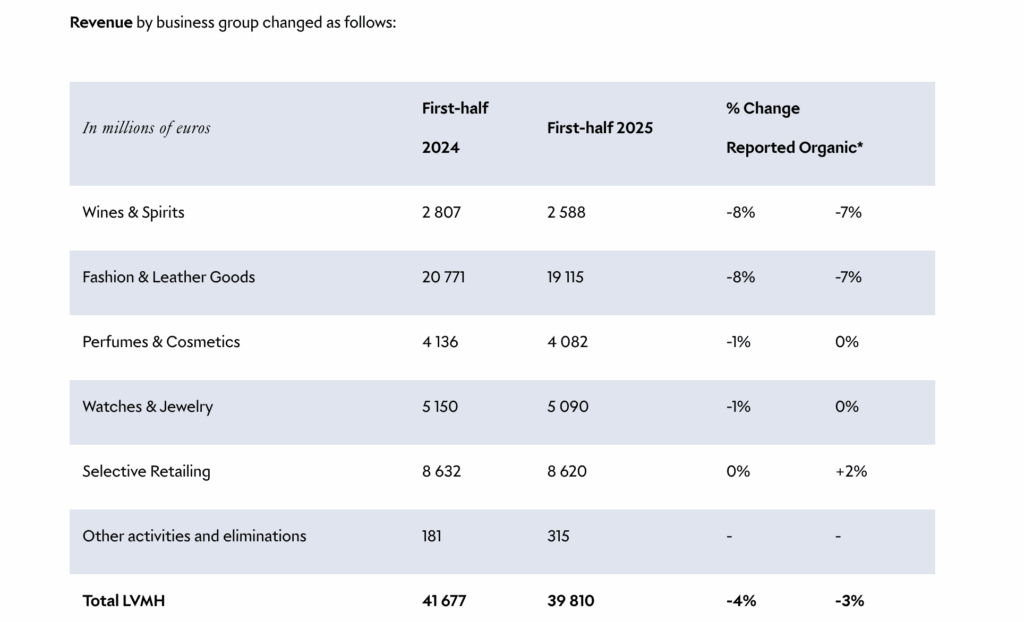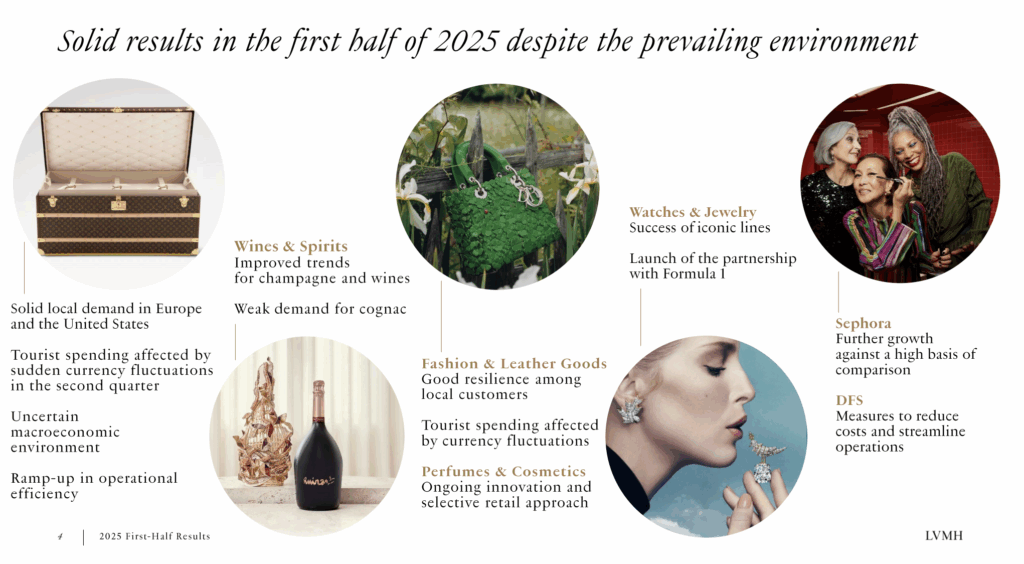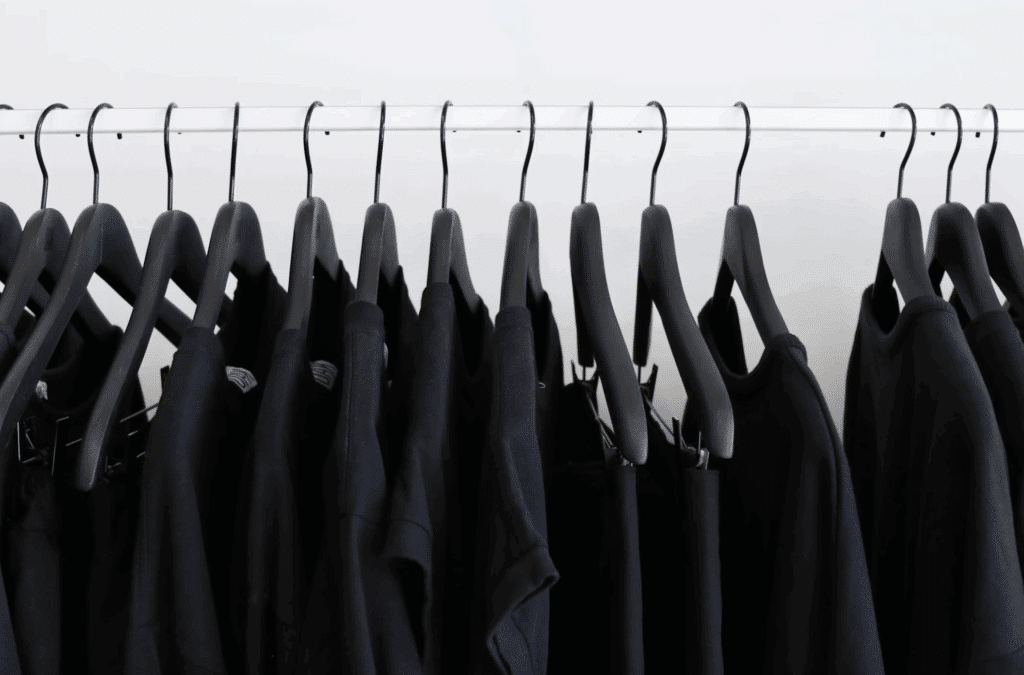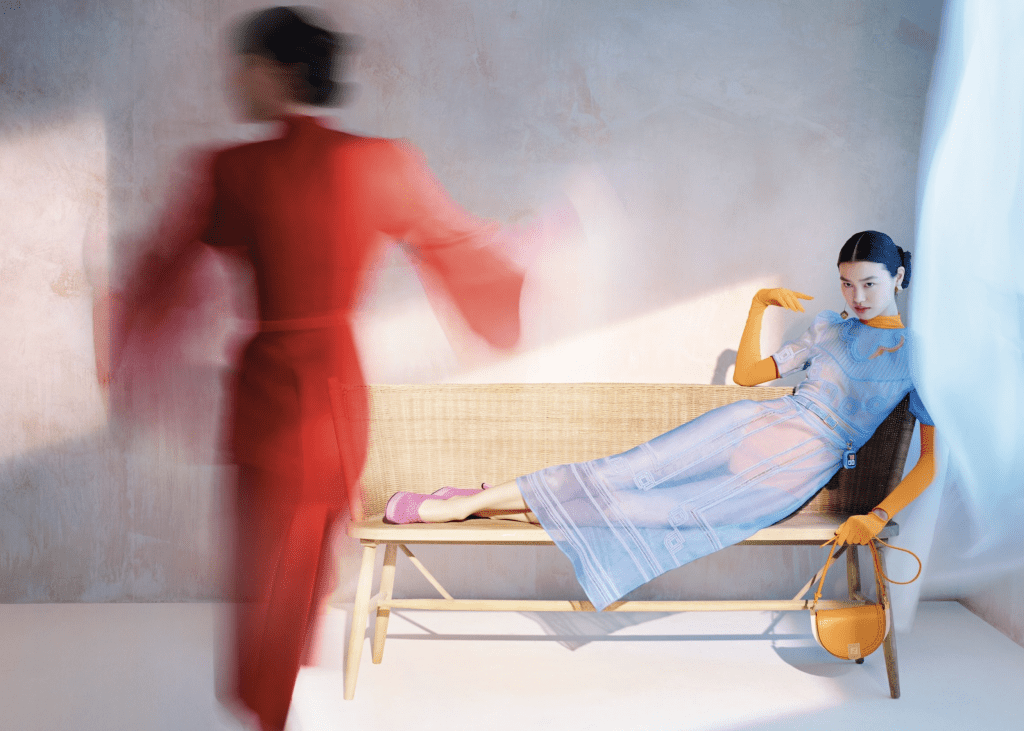LVMH says that it achieved a “solid performance” in the first half of 2025 “despite a disrupted geopolitical and economic environment.” The French luxury goods titan reported revenue of €39.8 billion ($46.8 billion) for the six months ending on June 30 – down 4 percent year-over-year – and a profit from recurring operations of €9 billion (equating to an operating margin of 22.6 percent), a decrease of 15 percent compared to the same period in 2024.
For LVMH’s largest division, Fashion & Leather Goods, revenue amounted to €19.1 billion (down from €20.8 billion in H1 2024); sales of Watches & Jewelry also declined slightly by 1 percent to €5.1 billion. Growth came by way of Selective Retailing, which includes Sephora, and the Perfumes & Cosmetics group, which maintained stable performance despite market headwinds.

Regionally speaking, Europe and the U.S. posted solid local demand, while Japan saw a decline following an exceptional first half of 2024 that was boosted by inbound tourism and a weak yen. The rest of Asia remained steady compared to last year, with an improvement in sales to local customers in Q2.
Fashion & Leather Goods Miss Expectations
While the Fashion & Leather Goods division remains LVMH’s primary profit driver, its sales fell by 9 percent (reported basis) to €19.1 billion – worse than analysts’ expectations of a 6 percent decline. This shortfall has amplified concerns about the health of the broader luxury sector, as demand for high-priced handbags and accessories shows signs of fatigue, particularly in Asia and the U.S.
A combination of consumer pushback against repeated price hikes and uncertainty stemming from U.S. trade tensions has weighed on performance. The threat of new tariffs on European imports – coupled with stock market volatility – has impacted confidence, while LVMH is wary of raising prices further for American consumers after evidence that previous hikes have already slowed sales. Analysts suggest that the luxury boom seen over the past few years may be entering a correction phase, with middle-income aspirational shoppers pulling back amid persistent inflation and broader economic anxiety.
Creeping “Big Luxury” Fatigue
LVMH’s financial performance in the first half of 2025 comes against the backdrop of creeping “luxury fatigue,” a growing sentiment that mega-brands are losing some of their allure among key consumer groups. After years of aggressive price hikes, highly publicized celebrity collaborations, and increasingly logo-laden products (all aimed to relentless revenue growth), many consumers are showing signs of exhaustion with the dominance of “big luxury” – and are instead gravitating toward smaller, niche brands that emphasize authenticity, craftsmanship, and understated design.
This shift is particularly pronounced among younger, affluent buyers, who have exhibited a penchant for “quiet luxury” aesthetics and exclusive, investment-grade items like fine jewelry, rather than the conspicuous logo-heavy handbags that have long fueled LVMH’s Fashion & Leather Goods division. Analysts at UBS recently noted that “investors are starting to question the long-term structural attractiveness of the industry,” with LVMH’s shares down nearly 27 percent since the start of the year, compared to a 15 percent decline at Kering and relatively stable performance at Hermès and Richemont, which cater to ultra-wealthy clientele.

Compounding – and in some sense, fueling – these challenges, LVMH, in particular, has faced a series of reputational controversies. In July, Italian labor inspectors revealed reports of exploitative working conditions at factories linked to LVMH’s ultra-luxury textile and cashmere brand Loro Piana. While the company has pledged to investigate and strengthen oversight, the allegations have sparked renewed scrutiny of luxury’s opaque supply chains.
Before that, Christian Dior faced backlash over cultural insensitivity and pricing policies, with social media criticism highlighting perceived tone-deaf marketing campaigns and steep price increases for signature leather goods. These incidents have coincided with a broader industry debate about how luxury houses can maintain their exclusivity and brand equity without alienating aspirational shoppers who feel increasingly priced out.
Industry experts also warn that the shift toward lower-priced products and beauty items – a strategy that LVMH and its competitors have pursued to capture new customers – carries risks of its own. While these accessible entry points can boost volume, they also risk diluting brand positioning if not carefully balanced with high-end offerings. HSBC analysts have pointed to “inconsistencies” in some of LVMH’s recent brand strategies, noting that consumers are beginning to question the value proposition of certain high-priced products.














